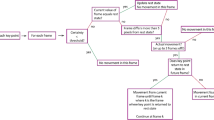Abstract
There have been a lot of psychological researches on emotion and nonverbal communication. Yet, these studies were based mostly on acted basic emotions. This paper explores how manual annotation and image processing can cooperate towards the representation of spontaneous emotional behavior in low-resolution videos from TV. We describe a corpus of TV interviews and the manual annotations that have been defined. We explain the image-processing algorithms that have been designed for the automatic estimation of movement quantity. Finally, we explore how image processing can be used for the validation of manual annotations.

Similar content being viewed by others
References
Abrilian S, Devillers L, Buisine S, Martin J-C (2005) EmoTV1: annotation of real-life emotions for the specification of multimodal affective interfaces. In: 11th international conference human–computer interaction (HCII’2005), Las Vegas, Nevada, USA, 22–27 July 2005 LEA
Bakeman R, Gottman JM (1997) Observing interaction. An introduction to sequential analysis, 2nd edn. Cambridge University Press, Cambridge, 0 521 45008 X
Banse R, Scherer K (1996) Acoustic profiles in vocal emotion expression. J Pers Soc Psychol 70(3):614–636
Bänziger T, Pirker H, Scherer K (2006) GEMEP—Geneva multimodal emotion portrayals: a corpus for the study of multimodal emotional expressions. Workshop “Corpora for research on emotion and affect”. In: 5th international conference on language resources and evaluation (LREC’2006), Genova, Italy, 23rd May 2006, pp 15–19. http://www.limsi.fr/Individu/martin/tmp/LREC2006/WS-Emotion/LREC06–WSemotion-proceeding-12.pdf
Boone RT, Cunningham JG (1998) Children’s decoding of emotion in expressive body movement: the development of cue attunement. Dev Psychol 34(5):1007–1016
Caridakis G, Raouzaiou A, Karpouzis K, Kollias S (2006) Synthesizing gesture expressivity based on real sequences. Workshop “Multimodal Corpora. From Multimodal Behaviour Theories to Usable Models”. In: 5th international conference on language resources and evaluation (LREC’2006), Genova, Italy, 27th May 2006, pp 19–23. http://www.limsi.fr/Individu/martin/tmp/LREC2006/WS-Emotion/LREC06-WSemotion-proceeding-12.pdf
Cowie R (2000) Emotional states expressed in speech. ISCA ITRW on speech and emotion: developing a conceptual framework for research, pp 224–231
De Silva PR, Kleinsmith A, Bianchi-Berthouze N (2005) Towards unsupervised detection of affective body posture nuances. In: 1st international conference on affective computing and intelligent interaction (ACII’2005). Springer, Beijing, 22–24 October 2005, pp 32–40
DeMeijer M (1989) The contribution of general features of body movement to the attribution of emotions. J Nonverbal Behav 13:247–268
Devillers L, Abrilian S, Martin J-C (2005) Representing real life emotions in audiovisual data with non basic emotional patterns and context features. In: 1st international conference affective computing and intelligent interaction (ACII’2005), Beijing, China, Spinger, Berlin, 22–24 October 2005, pp 519–526. http://www.affectivecomputing.org/2005
Douglas-Cowie E, Campbell N, Cowie R, Roach P (2003) Emotional speech; Towards a new generation of databases. Speech Commun 40:33–60
Ekman P (1999) Basic emotions. Handbook of cognition and emotion. In: Dalgleish T, Power MJ (eds) Wiley, New York, pp 301–320
Enos F, Hirschberg J (2006) A framework for eliciting emotional speech: capitalizing on the actor’s process. Workshop “Corpora for research on emotion and affect”. In: 5th international conference on language resources and evaluation (LREC’2006), Genova, Italy, 23 May 2006, pp 6–10. http://www.limsi.fr/Individu/martin/tmp/LREC2006/WS-Emotion/LREC06-WSemotion-proceeding-12.pdf
Gunes H, Piccardi M (2005) Fusing face and body display for bi-modal emotion recognition: single frame analysis and multi-frame post integration. In: 1st international conference on affective computing and intelligent interaction (ACII’2005), Beijing, China. Springer, Heidelberg, 22–24 October 2005, pp 102–110
Hartmann B, Mancini M, Pelachaud C (2005) Implementing expressive gesture synthesis for embodied conversational agents. Gesture Workshop (GW’2005), Vannes, France
Kapur A, Kapur A, Virji-Babul N, Tzanetakis G, Driessen PF (2005) Gesture-based affective computing on motion capture data. In: 1st international conference on affective computing and intelligent interaction (ACII’2005), Springer, Beijing, China, 22–24 October 2005, pp 1–8
Kipp M (2004). Gesture generation by imitation. From human behavior to computer character animation. Florida, Boca Raton, Dissertation.com. 1581122551. http://www.dfki.de/∼kipp/dissertation.html
Martin J-C, Abrilian S, Devillers L (2005) Annotating multimodal behaviors occurring during non basic emotions. In: 1st international conference on affective computing and intelligent interaction (ACII’2005), Beijing, China, Spinger, Berlin, 22–24 October 2005, pp 550–557. http://www.affectivecomputing.org/2005
Martin J-C, Abrilian S, Devillers L, Lamolle M, Mancini M, Pelachaud C (2005) Levels of representation in the annotation of emotion for the specification of expressivity in ECAs. In: 5th international working conference on intelligent virtual agents (IVA’2005), Kos, Greece. Springer, Heidelberg, 12–14 September 2005, pp 405–417. http://www.iva05.unipi.gr/
Martin J-C, Caridakis G, Devillers L, Karpouzis K, Abrilian S (2006) Manual annotation and automatic image processing of multimodal emotional behaviors in tv interviews. In: 3rd IFIP conference on artificial intelligence applications & innovations (AIAI’2006), Athens, Greece, 7–9 June 2006
McNeill D (1992) Hand and mind—what gestures reveal about thoughts. University of Chicago Press, Chicago, 0-226-56132-1
Newlove J (1993) Laban for actors and dancers. Routledge, New York 1 85459 160 6
Schröder M (2003) “Experimental study of affect burst.” speech communication. In: Special issue following the ISCA workshop on speech and emotion 40(1–2):99–116
Wallbott HG (1998) Bodily expression of emotion. Eur J Soc Psychol 28:879–896. http://www3.interscience.wiley.com/cgi-bin/abstract/1863/ABSTRACT
Acknowledgment
This work was partly funded by the FP6 IST HUMAINE Network of Excellence (http://www.emotion-research.net).
Author information
Authors and Affiliations
Corresponding author
Rights and permissions
About this article
Cite this article
Martin, J.C., Caridakis, G., Devillers, L. et al. Manual annotation and automatic image processing of multimodal emotional behaviors: validating the annotation of TV interviews. Pers Ubiquit Comput 13, 69–76 (2009). https://doi.org/10.1007/s00779-007-0167-y
Received:
Accepted:
Published:
Issue Date:
DOI: https://doi.org/10.1007/s00779-007-0167-y




